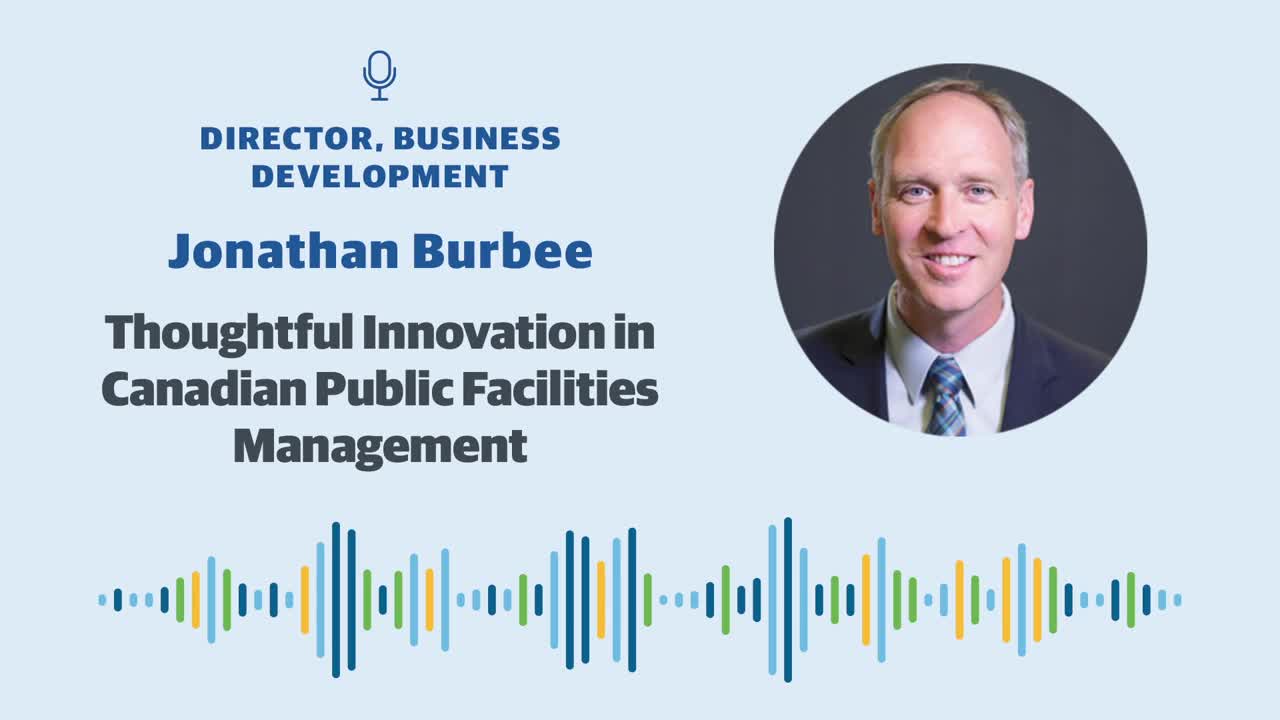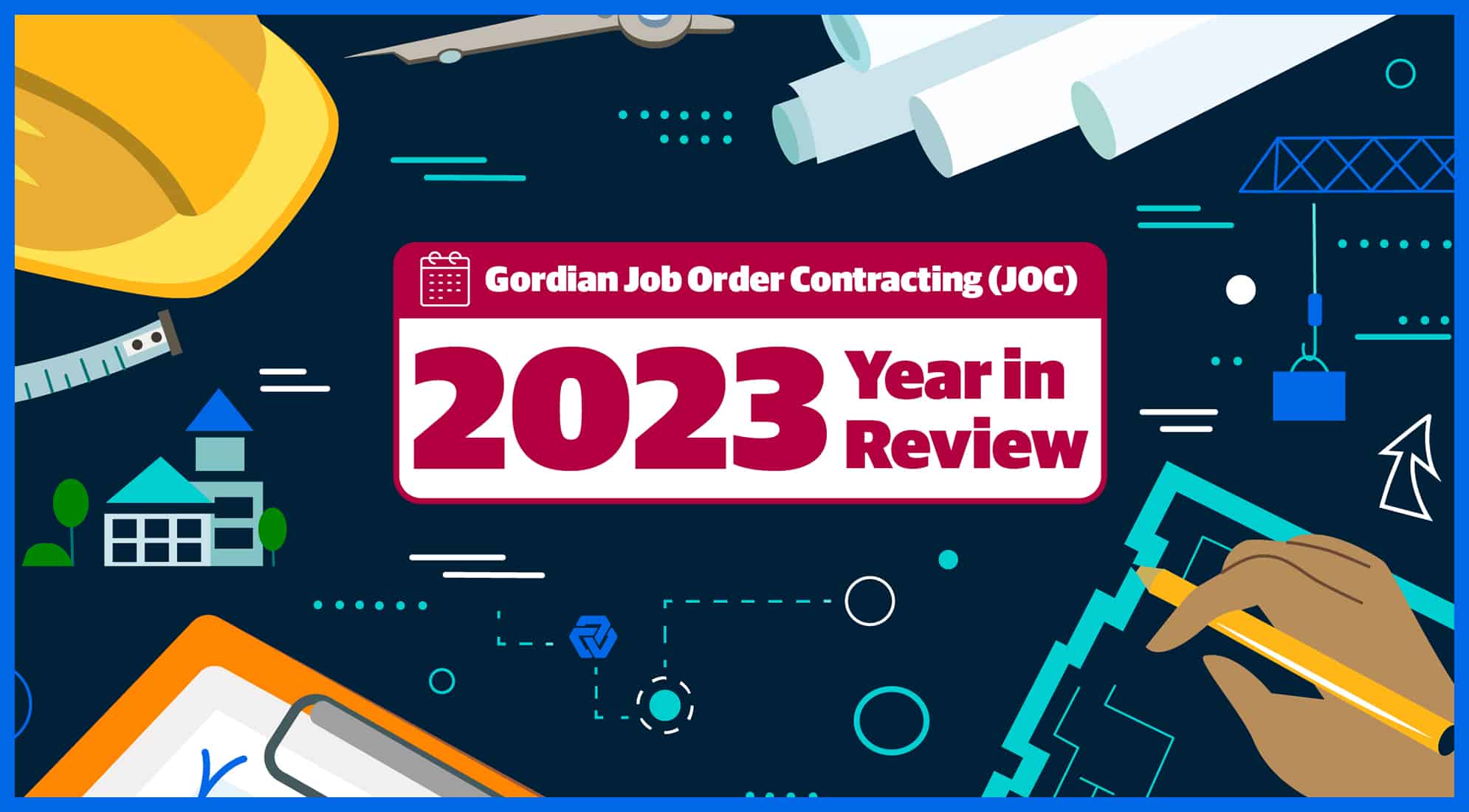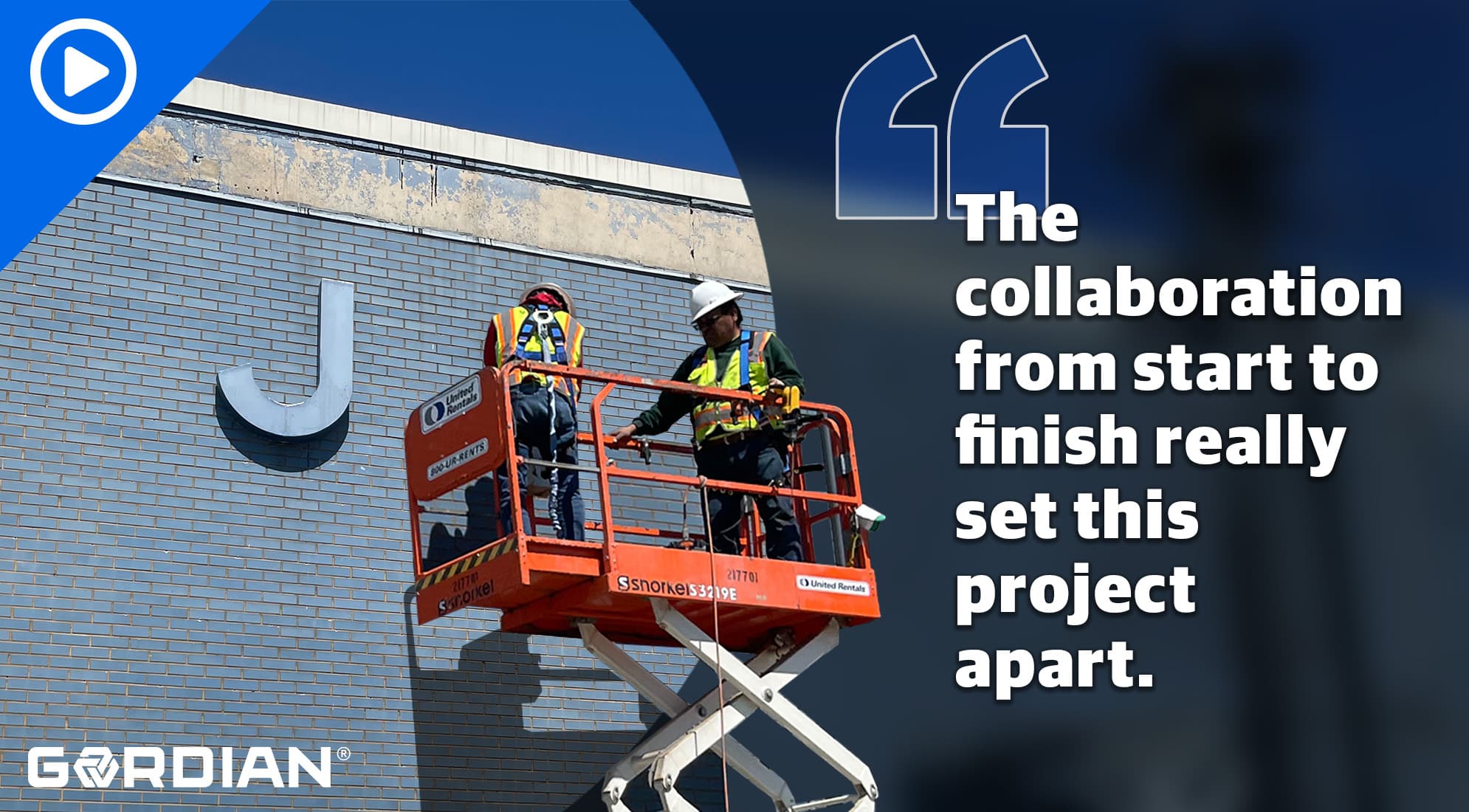
Thoughtful Innovation in Canadian Public Facilities Management
August 13, 2024
TRANSCRIPT
John: Welcome back to another episode of CGE Radio. I’m your host, J. Richard Jones, and it’s a pleasure to be with you today. When you look at doing a better job with facility professionals working in assessing and the procurement process as it pertains to construction services and public sector, there’s a lot of challenges. The good news is there’s also new technology to Canada that can really help.
Our guest today is going to talk about how his company helps professionals within the facilities building budget and maintenance areas to manage buildings within [the] public sector. A little bit about our guests first. He’s got a strong background as a public sector executive and leader. He’s been involved in real property management and construction, as well as construction engineering for over 23 years. He also had a career in the Canadian Armed Forces, where he led functions during international deployment to Kosovo and Afghanistan, and domestically at several military bases in support of the Vancouver Winter Olympic Games. As well, he’s been a public servant for 11 years within federal and provincial governments, having various roles as a senior portfolio executive. Most recently, he worked to assist with strategic capacity in supporting the provincial government’s response to the pandemic and natural disasters through digital-enabled, multi-channel, public-facing service delivery. He’s a designated real estate professional and a whole lot more. Please join me in welcoming Jonathan Burbee, Director of Business Development, Canada, for Gordian. Jonathan, welcome to the show.
Jonathan: Thanks very much, John. Thanks for having us.
John: You have done a lot, and you clearly understand the area of real estate and facility management, but also dealing with things like COVID and emergencies and tasks. I mean, when I was reading your bio, and we were just talking about this before the show, I mean, you supported the Vancouver Winter Olympic Games. I’ve got to imagine there’s a lot of stress and last-minute changes with that as well. Perhaps you could tell us a little more about your background. I mean, I certainly touched a little bit of it, but you’ve had a very interesting career so far, and I’m curious, as I’m sure our listenership will be, what led you to your current line of work?
Jonathan: Well, thanks. Thanks again for having us. I mean, it’s been quite an adventure, I’ve got to say, looking back. I mean, through the first couple dozen years of my career, they’re very much as you’d expect in a traditional buildings department and public works setting. You know, as much as you can say in a military context, I got to go to some interesting places. So, I was managing projects, leading operational maintenance teams, progressively working up to senior roles in the government, and more or less a conventional career pathway. But in 2017, we were asked to look at smart buildings. So that’s blending technology, sensors and controls to create high-performing buildings. And we’re really looking to get more sustainability outcomes out of that work. So that first whetted my appetite to the marriage between bricks and mortar and tech. And as you mentioned, the lateral move to Service BC, really to initially lift the business acumen. And then we got into the pandemic response. But I got an incredible immersion in the blend of technology and the practice of service. And I found myself involved with agile product teams, replacing legacy financial systems, and a whole new world of using data really to drive service improvement to citizens. So this just opened my eyes to the possibilities of digital transformation in the government in a way that I really hadn’t seen before. And so about a year ago, I joined Gordian to help expand the business in Canada. And now I get to look at it like I get to help many organizations rather than just one. So how I describe my leadership approach is where I can make the most impact is when I make others around me successful. And I really see that as my new mission when working with public sector leaders.
John: You know, it’s interesting because I was reading a little bit about Gordian as well, and it’s quite an interesting history. Can you tell us a little bit more about why you chose to get involved with Gordian? What’s the history of the company?
Jonathan: Well, Gordian’s been around for 30 years. The founder actually had very much the same professional background as I did. And there’s a real affinity with the public sector. I like to tell people we really help facilities professionals budget, build and maintain real property. And we get a lot of clarity from our vision. And that’s really to build better communities by turning data insights into smarter decisions. And you could describe communities loosely here. It could be your department as a community, for example. And there’s three main ways we work with customers. First is we help estimating in that pre-construction phase. So engineer and architect community recognize RSMeans. That’s a blue-ribbon standard for doing estimating projects. Even before our creation, that was 1940s. Second way is capital investment planning. That’s where you take your budgets and you turn it into a list of projects. And VFA facility is one of our software and assessment services in Canada, especially with strategic asset management teams and finance departments. And all four levels of government, education and health sector. I myself was a customer with defense and with the provincial government. And third, and this is more for the operational level with project delivery and procurement teams, is we use an innovative construction procurement method known as Job Order Contracting. And that’s a single competitively awarded compliant contract, which allows for the delivery of a program of projects. And we’ve had two instances of that in Canada, City of Mississauga (Ontario) and Richmond (British Columbia). But in the States, they’ve delivered over $3 billion worth of projects that way with public sector entities. So, through the work we do, Gordian is all about helping our partners keep their promises in communities.
John: You know, that’s a pretty good track record for sure. I’m going to give our listenership a little bit of a teaser too, because as we’re talking about technology, I think your company is involved with a technology that’s not necessarily new, but it is to Canada. And for all of the facility professionals who are dealing with assessment and are dealing with the area of public sector, as it relates to procurement and construction services, I think we’re going to have a little bit of information later in the show that they’re going to want to hear about. I want to come over to your article that you wrote about the future of workplace considerations. You know, the future of workplace technology, digital, hybrid working places, zero trust, cost efficiencies. I mean, I think in the intro we were talking about building budget and maintaining. These are all really big issues these days. How do you feel the future of work has imposed new demands? What are they when it comes to investment planning?
Jonathan: Yeah, John, we decided to write a little bit about the future of work since we just kept hearing again and again how the pandemic accelerated this workplace transformation concept we now know as the future of work. And this has really put new demands on investment planning, like you said. Of course, before the pandemic, traditional ways you go about building your project investment plan is hard enough. You had to look like what were the risks? How do you get ahead of your deferred maintenance? What are your program needs for clients? Maybe there’s some political drivers like regional benefits that all went into a multi-criteria analysis and you come up with a program. Well, with this increased adoption of hybrid work through the pandemic, we just imposed new demands. They’re having to consider where are we going to be located in the country, the geography? Where are we going to locate downtown or in the suburbs with a hub and spoke model? Are we going to drop space? These are all issues that governments are struggling with. And down to the building level, that hybrid mode requires additional investment for tenant improvements as they take on better space or reconfiguring extra space to go to that more collaborative mode rather than the private dedicated space. You know, it’s a competitive labour environment. Organizations need to win over employees by making workspace attractive and functional and really make the physical environment support the way we’re working now, or at least as good as they’re working at home. And so what we wanted to get across that through the adaptation to hybrid work, it’s a big shift in how teams now build their investment plan and one that really benefits from advanced expertise and mature digital solutions.
John: I think you hit on a good point. It’s about having a happy employee and that criterion has changed. I mean, you talk about open workspaces. I come from a generation where you worked in little bullpens when you’re starting out and then you had [a] private office. Now everybody wants that kind of open space to collaborate, retention practices and getting people to stay or attracting the right people and home and work-life balance certainly comes into that. It’s a new day. I mean, COVID, as terrible as it was, it’s opened up that hybrid approach as well, and it does require change, especially if you’re in the area of managing buildings and what’s going to be attractive. And I hear a lot about different smart cities and different things that are coming into play. I’d be curious to ask you, did COVID speed up some of the technology that is now available for some of the processes that you’re putting in place?
Jonathan: Absolutely. I mean, we’re living that right now by having a really good video call. I think that was more the exception than before. I mean, just the willingness to have to pivot, the overused word of the pandemic really, but just being open to doing e-commerce and digital identity and digital trust. And that was the basis of a lot of the work that I did in the past. Part of my career was just this whole acceleration of adoption of digital technology in every part of our lives. Whether it was shopping or meal delivery or how we do our work, just making sure that we can adopt that work thoughtfully and safely with attention to cybersecurity and all the appropriate measures. But just a much greater willingness to accept innovation that involves digital systems.
John: And I would imagine you get real-time feedback when something works well or when it doesn’t, right?
Jonathan: Yeah, it does. You know, one of the biggest benefits I found that I wasn’t really aware of is the behind-the-scenes work that comes with when you make anything digital, it also generates so much data that can be used for business purposes. And that’s one insight that I’ve seen and the strength of data science practice to really turn that data into useful information that you can act upon to improve outcomes for citizens.
John: I would imagine AI plays a role in that as well. Would you care to comment?
Jonathan: Well, AI has been with us in many ways for a little, for some time, hasn’t it? And it’s part of the conversation now with the risks and benefits all around. But certainly, as soon as you can take that structured data sets and organize the information, you can apply a lot of technology that’s right at our fingertips now. And lots of ethical concerns, of course, and I love the code of conduct that’s been developed by the national government to help guide that pending legislation. But the opportunities are big and they’re just in time, I’d say.
John: Yeah, I think that’s probably true. Jon, I know you’ve spent months talking to public sector leaders about managing their capital intensive physical [assets], and that’s a big issue. What are some of the common issues you’re hearing about and what are some of the themes that Canadian government executives should be paying attention to?
Jonathan: Well, John, Gordian spends a lot of time with our customers and listening to thought leaders, real property executives, procurement professionals, and there’s a lot going on right now. But for me, I’d say there’s really four themes that pop up when you look at those capital intensive assets, like buildings and public works. Those would be costs, the ability to deliver your program, staff capacity, and looking at how you operationalize corporate sustainability leadership. So, number one, and it’s no surprise that in a government context, the answer leads with money, you know, the impacts of inflation from supply chain have just been unprecedented. And when you consider that the budget share on facilities is often the second greatest, only next to human resources, people notice the stick of shock when the bids are coming back right now. So, departments are really getting less bang for the buck, and that raises questions, good questions from senior leadership and taxpayers, whether departments are really getting value for their money because of the increased costs. The next area of concern is that capacity gap. And when I mention that, I’m speaking to experience and numbers. And it’s not to say that the talent isn’t out there, it’s just that there’s gaps in filling vacancies with the right experience and skills needed to be good partners with contractors. For instance, you have lots of turnover in senior roles and those go-to experts and specialty functions. And we should pay attention to this because it’s not sustainable to expect that the superstars can continue to hold things together for the long-term without seeing adverse impacts. The flip side of this, of course, is that it signals an opportunity to do something differently. The third issue facing executives is the bringing action to corporate sustainability. And when I say that I’m going beyond green, I also include social sustainability with that when we’re talking about sustainable procurement. I think no matter what your political stripe, I think it’s a reasonable expectation that governments and public sector organizations show leadership in issues of public importance. For instance, we helped Ontario school boards prioritize investments that led to big reductions in energy and carbon emissions. The story that sticks with me for my time as a public servant was when one minister said, for this much money, we should expect more public benefit than just a better building. And really what they meant was that other benefits could be realized from that procurement than just the thing or service we were buying. Now, the thing with social sustainability is that governments also perform well, often perform well on policy and public statements. But to go beyond that and just being virtue signaling, some are challenged to live up to those aspirations. So take, for instance, many wonderful steps taken towards truth and reconciliation, like territorial acknowledgements and building cultural awareness. But many Indigenous leaders are calling out that without further action, are we really living up to TRC’s call for actions? And one of the biggest hurdles is finding ways to meaningfully engage Indigenous-led firms with economic opportunities. So often, government procurement processes can impose a barrier to small businesses from equity-deserving or equity-seeking groups like Indigenous businesses, or for that matter, women-owned businesses, because it’s a bit of a leap from having, say, strong trade skills into having a business that’s ready to do repetitive procurements, especially doing unpaid work, and preparing many more bids than are won. So I mentioned our Job Order Contracting program that had helped deliver over $3 billion worth of projects in the US, but what I didn’t talk about is that 35% of our contractors were from equity-deserving groups. I’ve seen American public executives, how they’ve advanced social procurement through Job Order Contracting. So to wrap this one up, to implement corporate sustainability, we really need to look at shifting procurement practices and what has for some time become a fairly static function in government. The last one was surprising to me, and I’ve run across many examples of governments having a hard time spending the money that they have in their renewal programs (mandate/ program delivery). And teams have gone to all this effort to attract and plan budgets, but then they’ve been challenged to spend that allocation, and I’m talking tens and hundreds of millions of dollars in some cities and federal departments. And that’s not good for anyone unless you make a little shift. So, four issues really, cost, staff capacity, action on corporate sustainability and program delivery. And the reason this matters that if we don’t address it, these issues could compromise mandate delivery, and ultimately erode trust and confidence in government.
John: You know, I want to come back to, if I could for a minute, Jon, to the Job Order Contracting. I think you’ve touched upon that a little bit. And as I understand it, it’s a means of using one competitive contract to deliver a program of projects, as opposed to in some organizations, they’re using scarce procurement and project delivery that ends up giving low capacity and low complexity and value. The JOC has got some obvious benefits. Can you go into that a little more?
Jonathan: And definitely, when you think, and it’s best suited for those renewal, repair, minor alteration projects, if it helps in terms of placing it in scale, think about those 50,000 to $4 million projects. And the problem that we’re solving is that many organizations are using the exact same methods and staff to deliver low complexity, low value, low visibility projects, as they are for the big announceable ones. I mean, whoever saw a tweet or an announcement on a boiler replacement or road repair, right? You don’t. It’s the new hospital bridge and research laboratory. And in fact, those renewal projects make up about 70% of the project count, and it’s chewing up an already limited capacity. So, if we shift a portion of this capacity to a more efficient delivery, that allows a better concentration of skilled staff where it belongs, on those hallmark front page projects.
To tell you a little bit more specifically about it is, [what comprises of and] when contracting process takes place, we invite contractors to come. We introduce them to a Construction Task Catalogue, which is an inventory of 300,000 light items of labour material and equipment inputs that allows you to do any kind of tasks in a construction process. We bring to bear our deep knowledge on construction costs and just the whole practice of building science. And then contractors come and bid an adjustment factor. So that’s where we introduce the competitiveness. And that is the basis for a whole program of projects.
So, we’re not the only ones that do this. In the States, there’s other firms that do it. The National Institute of Government Procurement did a survey a couple of years ago and talked about three main benefits. There’s time savings, closing those staffing gaps and better partnership with the industry. In terms of time savings, because you put all that work up front, you can start projects in a matter of days and weeks rather than months. And the average savings in admin time is three to nine months. Now, I just recently went through an RFP process and it’s hard. You put the effort into it, we may get the work or we may not. But I wonder why public sector firms or organizations ask firms to repetitively bid on similar work again and again and again. Let’s do eight different roof projects. Each time we have to submit the qualifications, cost the work out, and then you rinse and repeat. And so this, you compete once and you’re able to do multiple projects. This is attractive for both owners and builders. Makes a big difference if you can expand it, if you do the work in a hurry. Second one is in staffing gaps. There’s a group called the Government Business Council. They found that many agencies just aren’t resourced to support purchasing activities. And that impacts their performance, but also tends to frustrate industry. You know, contractors want a good partner on the other side of the table. It’s not about reducing numbers, it’s about shifting that effort to more interesting and necessary work. The third big outcome of that study was just the benefit to contractor relationships. And I can tell you through my experience, with contracting and the whole construction business, it can be pretty adversarial. Since Job Order Contracting is a program and not a project, owners and contractors get to work over three to five years and develop partnerships. So there’s a motivation that if contractors do good work at the established prices, they get to earn more work. And because prices are known from the start, because of that bidding process I talked about, locally indexed costs, just takes away those acrimonious disputes that really revolve around money, takes it off the table from the start. Because everyone loses when there’s friction and delays caused by disputes. Contractors also get to learn about the nuances of working in that supported program. So, let’s say they’re in a correctional centre or in a laboratory or in a higher education centre, they get to understand how to best support that program. This open collaborative working environment allows the project team to focus on quality. And it’s in everyone’s interest to deliver a successful project. Although we often think about cost certainty as being key, there’s really three benefits from the study. There’s the time saving, staff benefits and better relationships. And this has been validated with my owner interviews with builders in the program in Canada and also with owners.
John: You know, Jon, it sounds like this is a good time to talk about the new technology that’s available in Canada. We promised that earlier on. Can you tell us what it is? I know it’s designed to help with the procurement and construction service within government.
Jonathan: Absolutely. I mean, we won’t get into too much detail really in that, you know, of course, some of it’s proprietary. We mostly talk about the process and the benefits, but backed up behind that is robust technology. And it’s with intuitive interfaces. You can basically have like a menu on your mobile device or on your computer where you can go through and select the tasks that are appropriate to the project that you’re asking to do. And that just translates into costs in real time. And then you can actually be almost like a menu, just going on the list and you arrive at a cost and everyone’s clear on what the scope’s involved. So in the background, you’re bringing to light all the data science and technology that goes into collecting that information from reliable sources for labour and material and equipment. And it feeds that whole construction task catalogue that goes there. We’re very proud of the technology that we’re using. We’re very proud of, you know, the ability to work in cloud or ability to work with data sovereignty in mind, you know, in a Canadian market. We’re proud of all that goes behind it, but really its good design is when you don’t even notice it. It’s meant to be seamless. It’s meant to be accessible for any user without a lot of training. So we’re really proud of our product team, really proud of the data teams at the many cost engineers and researchers that do that work, that feed the system. But it’s really about the business outcome as opposed to a shiny new toy.
John: Sounds like it really enhances the process. Is there any data from the US and how it works in comparison to the current process now in Canada?
Jonathan: Absolutely. I mean, I did mention the administrative savings times is three to nine months. Most teams who are using Job Order Contracting are able to complete their whole project in nine weeks. Those using traditional methods like design, bid, build, or construction managed, you know, of course it depends on the scale and size of the project, but most of those teams are all well above 12 weeks and beyond. We’ve done some pretty good academic studies using sample sizes of around 300. And we’ve got some great other examples just to offer if you want to get in more detail later. A lot of this information is available on our website. If your listeners are interested in knowing more, you can make available to them independent research studies that talks about some of the quantifiable benefits.
John: Yeah, because I think you’ve got videos available as well on Job Order Contracting, right?
Jonathan: We do. You know, when I was thinking about whether it was a good fit for me to join Gordian, it honestly, it took me a little while to get my head around it. And so thankfully the company has produced, it’s a short three-minute video, and it really lays it out really clearly what the benefits are for owners and for contractors and how it just improves this kind of construction project.
John: So if somebody can literally go to your website and contact you guys or fill out a form and you’ll get in contact with them and share all this good stuff.
Jonathan: Absolutely, go to Gordian.com. There’s a whole page set up just for Canada. If you have a particular interest or question, just fill out a contact us form. Someone from the team will reach out. Like I said, there’s lots of good content, independent research, or you can reach out to me directly through LinkedIn or in my contact info if it’s in the show notes. Yeah, happy just to talk about and get feedback really. A lot of this process is relatively new in Canada, as I mentioned, aside from Richmond and Mississauga. So we’d love to hear feedback and questions because it just makes us be more thoughtful in how we roll it out.
John: Well, it sounds like you and your company are a great resource to take advantage of. Jon, what advice would you have for facility professionals who are working within public sector today?
Jonathan: John, if there’s one idea I want your listeners to take away from this session is that when it comes to managing a real property portfolio and all the procurement that goes along with that, I encourage them to create the environment for thoughtful innovation. And if they do this, public sector leaders will be in a better position to move from the status quo to meet their mandate and keep their promises in communities and companies like ours can help you in this work.
John: That’s excellent advice. You’ve been listening to CGE Radio and we’ve covered a lot today. And we’ve been talking about helping facility professionals to build budget and maintain property and public sector. But we’ve talked about so much more. We’ve talked about new technologies. We’ve talked about the public procurement process and efficiencies. And I want to thank our special guest today, Jonathan Burbee. He’s kindly given us a lot of direction and information and he is the Director of Business Development Canada for Gordian. Thanks so much.
Jonathan: Happy to be here, John. Thanks for having me.
Share this:






